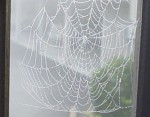 I love looking at dew or frost spangled spider webs, there is structure, fragility, beauty and practicality all woven (groan) together. Of course, we don't like them in our houses - though there are many corners of Dibley manse where dusty webs bear witness to my apalling standards of house keeping and the industry of the local spider population.
I love looking at dew or frost spangled spider webs, there is structure, fragility, beauty and practicality all woven (groan) together. Of course, we don't like them in our houses - though there are many corners of Dibley manse where dusty webs bear witness to my apalling standards of house keeping and the industry of the local spider population.
Way back when I was beginning to learn about 'theological reflection' someone introduced the metaphor of the spider's web, and it is one that to this day remains one of the most helpful for me, and one I enjoy playing around with - if not literally!
Like all metaphors and models it is imperfect, but it offers me a balance for the "pastoral cycle" which has dominated (and is a good basis for reflection).
A spider web needs anchor points - but what are they? How many are needed? Must they always be the same? A multi-disciplinary approach perhaps?
A spider web has loads of different strands all meeting at, or passing through a central point - a theocentric or christocentric model perhaps?
There are stands that move around the web, linking the different anchorage threads, some closer to the centre, some further out. In some, but not all, webs strands may skip over some threads to reach others and/or the spacings may be varied. Are there echoes of people like Westerhoff III (great name!) on spiritual nurture here?
The whole thing is practical - a dinner trap. At the same time it is fleeting - how quickly webs can be brushed away.
In this mix of beauty, structure, fragility and practicality there seem to be echoes of the contingence and particularity of all theological reflection. All too soon the web is gone, though usually the anchor points remain waiting for another spider to build another web on another day.
Sometimes I find myself making odd connections - a presentation on spiritual care of people with dementia seemed to connect somehow with my sense that 'the past' is a 'resource' for thinking understanding our 'now' (is there any word I don't need to 'problematise'?!). Someone looking at pastoral care of ministers saw the 'disinterment' of past as parallel to the cleansing of old wounds and traumas that can occur in counselling sessions - in other words, it is precisely by engaging with our own 'past', personal or corporate, that we are enabled to become more whole, more healthy. These aren't 'pastoral cycle' iterations, they are 'spider web' connections. Both are valid, neither is superior - and I guess so long as I learn from each I am growing in some senses.
(Oh, and for those that like a nice simplistic Biblical parallel, spider webs are a bit like fishing nets... and, in cynical mode, some models of evangelism are perhaps reflective of the predatory nature of the spider web!!! "I will make you spiders of men, spiders of men, spiders of men..." Or not. ;-) )